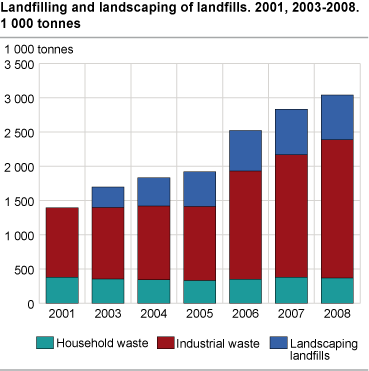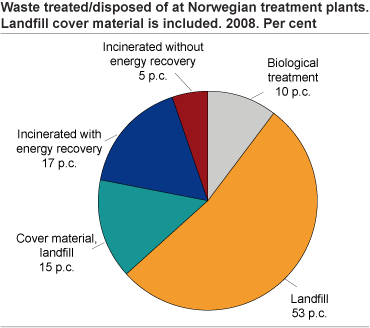Content
Published:
This is an archived release.
More contaminated soil to landfills
About 3.8 million tonnes of waste was treated at Norwegian waste treatment plants in 2008. This is an increase of 8 per cent compared with 2007. Waste to landfill - up 10 per cent - contributed most to this growth. The observed increase to landfills was mainly related to increased amounts of contaminated soil.
Just above half of the waste was deposited at Norwegian landfills. The other half was either incinerated or biologically treated. In total, this constitutes 35 per cent of all Norwegian waste.
| Year |
Biological
treatment |
Landfill | Incineration |
Final disposal
(landfill and incineration without energy utilization) |
|||||||||||||||||||||||||||||||||||||||||||||||||||||||||||||||||||||||||||
|---|---|---|---|---|---|---|---|---|---|---|---|---|---|---|---|---|---|---|---|---|---|---|---|---|---|---|---|---|---|---|---|---|---|---|---|---|---|---|---|---|---|---|---|---|---|---|---|---|---|---|---|---|---|---|---|---|---|---|---|---|---|---|---|---|---|---|---|---|---|---|---|---|---|---|---|---|---|---|---|
| Total |
Energy
utilization3 |
Without energy
utilization |
|||||||||||||||||||||||||||||||||||||||||||||||||||||||||||||||||||||||||||||
| 2008 | 455 | 2 382 | 981 | 755 | 226 | 2 608 | |||||||||||||||||||||||||||||||||||||||||||||||||||||||||||||||||||||||||
| 2007 | 440 | 2 171 | 922 | 712 | 210 | 2 381 | |||||||||||||||||||||||||||||||||||||||||||||||||||||||||||||||||||||||||
| 2006 | 347 | 1 933 | 846 | 631 | 215 | 2 148 | |||||||||||||||||||||||||||||||||||||||||||||||||||||||||||||||||||||||||
| 2005 | 324 | 1 413 | 814 | 593 | 220 | 1 633 | |||||||||||||||||||||||||||||||||||||||||||||||||||||||||||||||||||||||||
| 2004 | 351 | 1 421 | 844 | 626 | 218 | 1 639 | |||||||||||||||||||||||||||||||||||||||||||||||||||||||||||||||||||||||||
| 2003 | 277 | 1 399 | 830 | 614 | 216 | 1 615 | |||||||||||||||||||||||||||||||||||||||||||||||||||||||||||||||||||||||||
| 2001 | 284 | 1 396 | 669 | 489 | 181 | 1 577 | |||||||||||||||||||||||||||||||||||||||||||||||||||||||||||||||||||||||||
| 1998 | 99 | 1 928 | 470 | 343 | 127 | 2 055 | |||||||||||||||||||||||||||||||||||||||||||||||||||||||||||||||||||||||||
| 1995 | 52 | 1 895 | 493 | 360 | 133 | 2 028 | |||||||||||||||||||||||||||||||||||||||||||||||||||||||||||||||||||||||||
| 1992 | 21 | 1 687 | 342 | 250 | 92 | 1 779 | |||||||||||||||||||||||||||||||||||||||||||||||||||||||||||||||||||||||||
| 1 | Waste incinerated or landfilled by establishments in manufacturing is excluded. |
| 2 | Waste for material recovery excluded. |
| 3 |
Calculated from an average energy recovery rate of 77 per cent at Norwegian waste
incineration plants. |
| Source: Statistics Norway. | |
Contaminated soil handled more properly
Close to 2.4 million tonnes of waste was deposited in 2008. This is an increase of 10 per cent compared with 2007, and 69 per cent more than in 2005. Earlier years, from 2003 to 2005, waste amounts deposited on landfills summed up to about 1.4 million tonnes per year. The observed growth recent years was mainly caused by increased depositing of contaminated soil. Contaminated soil consists of soil, rock- and gravel substances from construction work, which require special treatment due to its pollution potential. However, it is not classified as hazardous waste. Increased governmental focus on the pollution potential of this type of waste, and consciousness-raising with regards to the handling of this type of waste, is probably the main reason for observed growth in this waste type. In addition, intensified construction activity may also have contributed to the growth. See State of Environment Norway for more information about contaminated soil.
Increase in waste incineration
Norwegian incineration facilities received 981 000 tonnes of waste in 2008. This is 6 per cent more than the year before, and 20 per cent more than in 2005. The observed growth since 2005 has been constant, but however, less than the general growth in the waste amounts. Increased activity at existing incineration plants and initiation of new facilities caused the growth in waste to incineration from 2007 to 2008.
Growth in biological treatment
In total 455 000 tonnes was composed or used for biogas production in 2008. This is just above 3 per cent more than the year before and 60 per cent more than in 2001. Only just about half of this was food waste. The remaining was garden waste and sewage sludge. As a result of initiation of new biogas treatment facilities and increased activity at existing treatment plants, the waste amount used for biogas production doubled from 2007 to 2008.
Tables:
Contact
-
Camilla Skjerpen
E-mail: camilla.skjerpen@ssb.no
tel.: (+47) 48 22 72 14
-
Mona E. Onstad
E-mail: mona.onstad@ssb.no
tel.: (+47) 48 59 61 86


